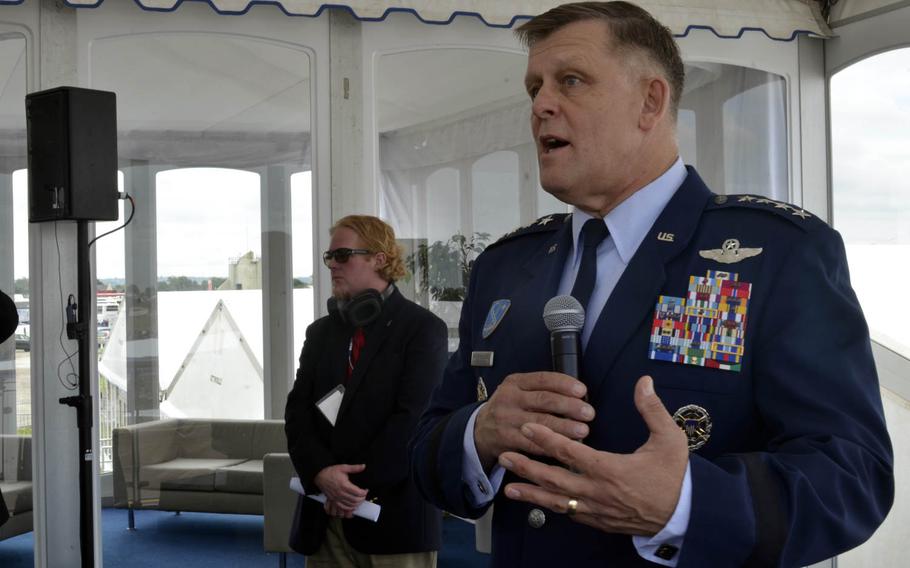
Gen. Frank Gorenc, commander of US Air Forces Europe, discusses the capabilities of the F-35 Lightning II jet during the Royal International Air Tattoo at RAF Fairford, England, Friday, July 8, 2016. Two squadrons of F-35A fighter jets are slated for permanent station at RAF Lakenheath, England in 2020. (William Howard/Stars and Stripes)
RAF FAIRFORD, England — Gen. Frank Gorenc, commander of U.S. Air Forces Europe, showcased the service’s F-35 Lightning II during the Royal International Air Tattoo on Friday.
Two of the three Lockheed Martin F-35 Lighting II variants debuted at the annual air show — the Air Force’s conventional take-off and landing F-35A and the Marine Corps short take-off and vertical landing F-35B.
This was the first time the F-35B had arrived in Britain, which plans to use the aircraft on its new Queen Elizabeth-class aircraft carriers currently under construction. The British air force and navy plan to operate 138 F-35Bs.
The F-35B was slated to make its first appearance in Britain in 2014, but an engine fire in the U.S. grounded the entire fleet at the time.
Gorenc lauded the F-35’s capabilities, comparing them favorably with the combat-proven, twin-engine F-22 Raptor.
“These aircraft have the capability to contribute to almost every mission,” he told an audience of allied military, press and industry representatives assembled for RIAT, the world’s largest purely military air show.
“All of the lessons learned with the F-22 are imbedded as improvements and innovations in the F-35,” he said.
Gorenc said the F-35 made data-sharing more accessible for pilots in the cockpit.
“I think that the most important, significant improvement in respect to the F-35 is something that we call sensor fusion,” Gorenc said. “All of that information that used to be very training intensive is now presented to the aviator right in front of them.”
Gorenc said his son-in-law, Lt. Col. Stephen Nichols — a pilot with more than 700 flight hours in the F-16 Fighting Falcon — recently tested the combat performance of the F-35A.
“My son-in-law got a lot of sorties that week and needless to say he was very happy with the airplane,” Gorenc said. “Basically I’m living vicariously through him.”
Two squadrons of U.S. Air Force F-35A fighter jets are slated for permanent station at RAF Lakenheath, England in 2020.
Lt. Gen. Jon Davis, commandant for aviation, Headquarters Marine Corps, said his priority is to get the F-35B integrated into the fleet as soon as possible with a production of 20 jets every year.
“The fact that we’re putting this aircraft in the hands of young aviators — this information generation — means we’re going to be able to really leverage the capabilities of this aircraft,” Davis said during a press conference. “Bottom line is we’re on track building out our fleet.”
Davis said 16 F-35Bs will be stationed at Marine Corps Air Station Iwakuni, Japan by July 2017 with plans for 20 squadrons across the fleet by 2032.